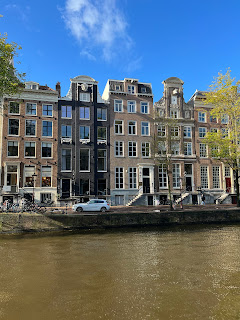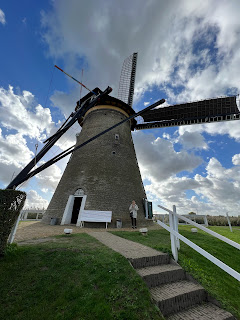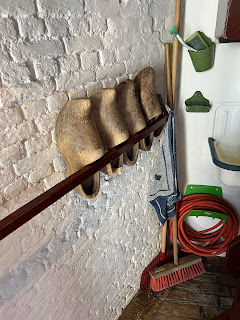Saturday, October 1st:
After a delicious breakfast at the INK hotel we headed to the Royal Palace to meet our tour guide, Tijs.
[The construction down the street where our hotel is]
He introduced himself, told us we were signed up for a four hour walking tour (we do love to walk), and then started telling us about the Royal Palace. A couple minutes later it started to POUR. We ducked into a covered alleyway and Tijs continued to tell us the history of Amsterdam and how he was going to take us on a walk through time during our tour. I was so excited! He pulled out a few old map of the city and showed us what it was like in the 16th, 17th, and 18th centuries. He told us we were going to start the tour in the oldest areas and then work our way out to the newer spots.
[1554 - Canals were present]
[1649 - Inner canal rings were added]
[1662 - More canal rings are finished]
[1770 - Expansion of the city center comes to an end]
It only ended up raining for about 15 minutes and then it was done. YAY! When it was over a beautiful double rainbow formed over the Royal Palace.
This mid-17th century building was originally built as a City Hall, but was converted into a Royal Palace by Louis Napoleon who was given the throne by his brother, Napoleon Bonaparte (yes, that Napoleon Bonaparte). King Louis I of Holland, as he was known, only ruled for a few years. But during his rule he had a balcony installed on the front of the building, which is still used today by the royals during special events.
We then headed over to a small open area where the first modern securities market stock exchange started. We then walked down a tiny side street to the Stadsbank van Lening which is the oldest credit distributor in Amsterdam (1614).
[Stadsbank van Lening]
[Stadsbank van Lening]
We continued to wind our way through the oldest parts of the city until we came to the Bloemenmarkt. This market will filled with not just flowers, but their bulbs too! I don't know how well tulips grow in Chicago, but I was very temped to buy a few bulbs and give it a try.
Tijs then showed us a few smaller churches and told us about Amsterdam's tense relationship with religion. In short, in the late 16th century Amsterdam joined a revolt against the Spanish rule. Spain was very Catholic at this time (as was Amsterdam), but the people revolted so much that they removed the Catholic influence from the city and most people converted to Protestant worship.
[Amsterdam is a very tolerant city and has many LGBTQ+ friendly areas]
[Can you see how the black house is leaning forward? That is on purpose.]
As we worked our way into the 17th century areas, Tijs told us about the Dutch Golden Age and how merchants in Amsterdam got very rich due to trade. Amsterdam was the leading party on trade during that time and it became the wealthiest cities in the Western Hemisphere. Have you ever heard of the Dutch East India Company and the Dutch West India Company? I'm sure you have! The wealthy merchants in Amsterdam owned a lot of stock in those companies. They traded all over the world and were heavily involved with the Atlantic slave trade.
This building located at Herengracht 380 is now the NIOD Institute for War, Holocaust and Genocide Studies. It's ironic because it was occupied and used by the Nazi's during WWII to study the "Jewish Question" and to learn about all those who oppose Nazi rule.
Unfortunately Amsterdam is having issues. Some of the canal walls are starting to buckle. The houses are built very close to the canal, so if the walls fail, the buildings may collapse too. They have started reinforcing the old canal walls with sheet piling and then they try to make it look nice with plants.
We then came across this pretty bridge that was covered with pumpkins and other fun fall plants. Tijs told us that since people don't have gardens of their own they will plant things in front of their houses (mostly on the sidewalks) or on bridges.
We then stopped by the West India House, which was the former headquarters of the Dutch West India Company. It was in this building that the DWIC governors ordered the construction of a fort on a small island called Manhattan! They would name this area New Amsterdam, which would later become New York.
In the courtyard is a statue of Peter Stuyvesant who was the governor of New Netherland (which is now part of the north eastern US).
Lastly, this building also houses the John Adams Institute. Before he became President of the United States, John Adams lived in Amsterdam and worked as a diplomat. He forged a great relationship between the US and the Netherlands and they officially became the second country to recognize our independence.
Our final stop was to get a look at these two old buildings that were built in 1614! They are leaning a lot, but are apparently very stable.
I don't even know how many miles we walked around town, but this tour was such a great way to see the city! Like I said before, make sure you see Amsterdam by canal AND by foot. There are benefits to both!
Tijs walked us back to the hotel and we got a quick bite to eat before another tour guide and driver showed up. We all hopped in the black Mercedes SUV and headed down to Kinderdijk to see the windmills!
26% of land in the Netherlands is below sea level. The Dutch are very creative engineers and have developed a system that allows them to pump out the water and use the land.
When we first arrived at the UNESCO World Heritage Site, we headed to the pumping station to learn about how the 19 windmills work together to pump the water.
We then headed out into the site and walked along the dikes to Nederwaard No 2, which is working windmill/museum that you can go through.
[Nederwaard No 2]
We took turns going inside (it's not wheelchair accessible) and climbed our way to the top of the windmill.
[Clogs!]
[It's me!]
It was so cool to see how the windmills work and where the families that work them live. And yes, people still live in and work these windmills!
We continued to walk up the dike where we saw more and more windmills!
After exploring the area we jumped on a little canal boat and took it back to the main entrance.
On the way back to Amsterdam we drove past Delft (famous for their blue pottery) and saw the soaring tower (356 ft) of the New Church (I like how churches that were built in the 14th century are considered "new"). This church is where the members of the House of Orange-Nassau (the ruling family) have been buried since 1584.
[Gotta feed the kiddo when we can]
We got back to Amsterdam after the sun went down, so we had dinner at the restaurant and then Josh and I went on a date to find some gelato.
















































No comments:
Post a Comment